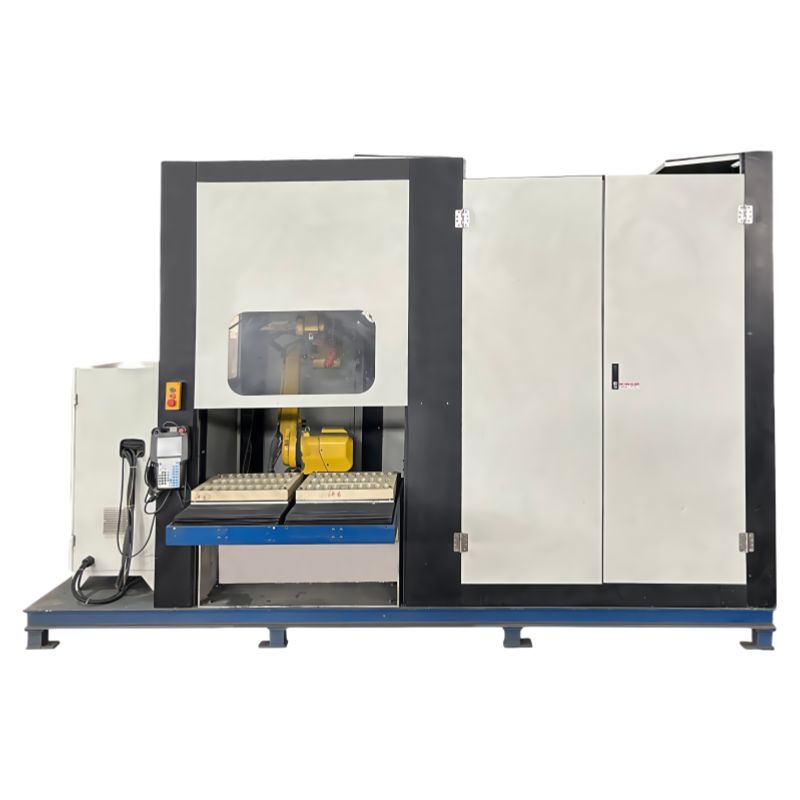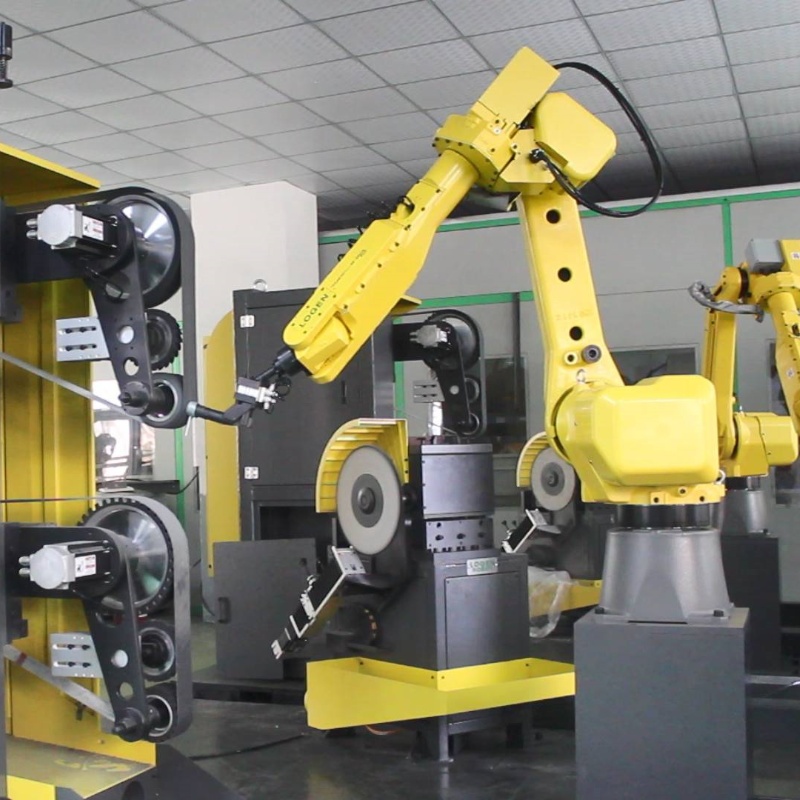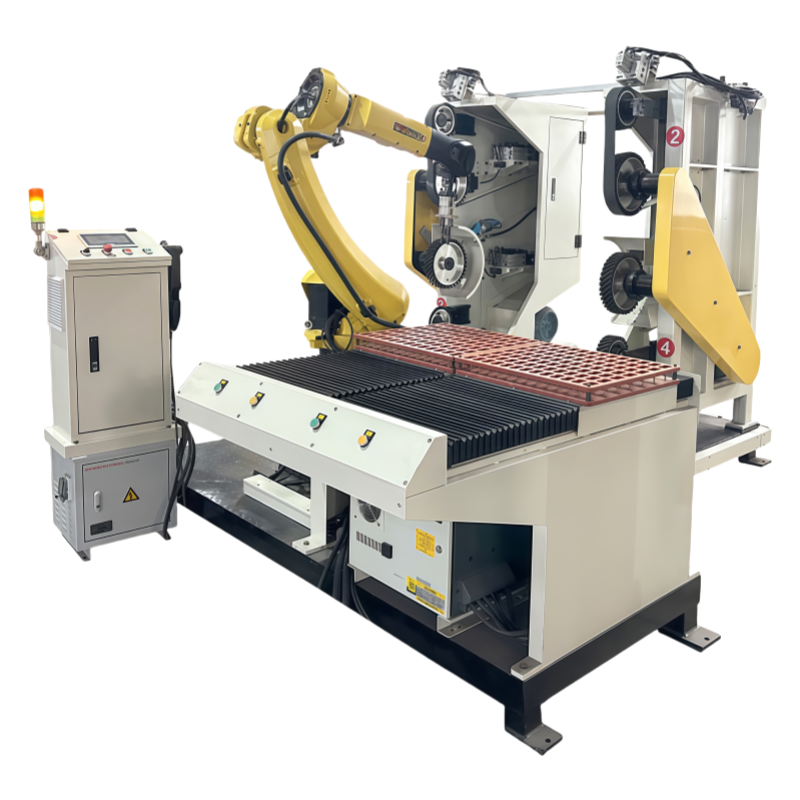FANUC Robotic Grinding and Polishing Cell for Brass Sanitary Faucets is an automated system designed to perform essential tasks such as grinding, sanding, deburring, polishing, and buffing of brass faucet parts. This system ensures high precision, consistent quality, and enhanced production efficiency. Here's an in-depth look at the functions and capabilities of this advanced robotic cell tailored for the sanitary faucet industry.

Overview of FANUC Robotic Grinding and Polishing Cell for Brass Sanitary Faucets
FANUC’s robotic grinding and polishing cells are cutting-edge solutions designed for high-quality surface treatment of various brass parts, particularly sanitary faucets. The robotic cell utilizes FANUC’s advanced industrial robots, capable of performing intricate tasks with precision and speed. The system integrates various grinding, sanding, deburring, polishing, and buffing operations, offering an all-in-one solution for the manufacturing and finishing of brass faucets.
Key Functions
Grinding:
Purpose: The grinding process is essential for shaping and finishing brass faucet parts. It removes excess material, corrects dimensional inaccuracies, and ensures the surface is smooth.
Process: The robotic system uses abrasive grinding tools such as wheels or belts to remove material from the faucet part, achieving the desired size and shape. The robot moves in precise, controlled paths, ensuring consistency across all parts.
Benefit: This eliminates manual labor, increases production rates, and guarantees uniformity, crucial for mass production of high-quality faucets.
Sanding:
Purpose: Sanding is used to smooth the surface after grinding. It eliminates small scratches, rough areas, or imperfections left behind by previous processes.
Process: The robotic cell employs sanding belts or discs, adjusting the grit size depending on the required finish. The robot arm adjusts its motion to cover all surfaces of the part uniformly.
Benefit: Provides a smooth, refined surface that is ready for further polishing. Sanding ensures that all visible imperfections are removed, preparing the faucet parts for a high-quality finish.
Deburring:
Purpose: Deburring is a critical process in faucet manufacturing, as it removes sharp edges and burrs that can result from the casting or machining process. These sharp edges are dangerous and can lead to product defects or safety concerns.
Process: The robotic system uses specialized deburring tools, such as brushes, rotary discs, or abrasive pads, to gently remove burrs and sharp edges. The robot ensures that all edges are treated, avoiding any missed areas.
Benefit: Prevents safety hazards, ensures that parts are smooth and safe to handle, and improves the overall functionality and aesthetic quality of the faucet.
Polishing:
Purpose: Polishing enhances the surface quality, giving the faucet part a glossy, reflective finish that improves both appearance and corrosion resistance.
Process: The robot uses polishing pads or cloths, combined with polishing compounds, to achieve a smooth, high-gloss finish. This process involves multiple steps, beginning with finer abrasive compounds and progressing to finer, more reflective compounds.
Benefit: Provides a high-quality finish that not only improves the visual appeal of brass faucets but also enhances their resistance to corrosion, ensuring long-term durability.
Buffing:
Purpose: Buffing is the final step in the surface treatment process, designed to achieve the highest level of smoothness and shine. It is particularly important for high-end brass faucet finishes.
Process: The robotic buffing system uses soft pads, usually combined with special buffing compounds, to polish the surface to a mirror-like finish. The robotic arm precisely manipulates the buffing pads to ensure an even and flawless outcome.
Benefit: Buffing provides the final glossy finish, making the faucet visually appealing and enhancing its functionality by reducing friction and preventing buildup of contaminants.
Process Workflow
Part Loading:
Grinding:
Sanding:
Deburring:
Polishing:
Buffing:
Finally, the buffing process is performed to achieve a high-gloss, mirror-like finish, giving the faucet its final aesthetic appeal.
Quality Inspection:
After the grinding, sanding, deburring, polishing, and buffing processes, the robotic cell may include integrated sensors or vision systems to inspect the surface quality of each faucet part. Any defects or inconsistencies can be detected and corrected in real-time.
Part Unloading:
Benefits of the FANUC Robotic Grinding and Polishing Cell
Increased Efficiency: The automated robotic system speeds up the entire grinding, sanding, deburring, polishing, and buffing process, reducing production time and increasing throughput.
Consistent Quality: With robotic precision, each faucet part receives the same high level of treatment, ensuring consistent surface quality across all units.
Cost-Effective: By automating these processes, the need for manual labor is reduced, lowering overall production costs.
Improved Safety: Automating tasks like grinding and deburring minimizes the risk of injuries that could occur from manual handling of sharp parts or high-speed machinery.
Customization: FANUC robotic systems can be configured to handle various faucet designs and sizes, making the system versatile and adaptable to different production requirements.
Environmentally Friendly: The robotic system can be equipped with dust collection and waste recycling systems, minimizing environmental impact and improving workplace cleanliness.
Applications
Sanitary Faucets: Primarily used for finishing and refining brass faucet parts used in bathrooms, kitchens, and other sanitary fittings.
Plumbing Components: Suitable for grinding, sanding, and polishing other metal plumbing parts, including valves, handles, and connectors.
Decorative Brass Items: Can be used for finishing various decorative brass products, including knobs, handles, and other hardware components.
Conclusion
The FANUC Robotic Grinding and Polishing Cell for Brass Sanitary Faucets is an advanced automation solution that improves the efficiency, quality, and safety of the faucet manufacturing process. By incorporating grinding, sanding, deburring, polishing, and buffing into one system, it ensures a flawless finish for brass faucet parts while reducing production costs and increasing throughput. This robotic cell is ideal for manufacturers looking to streamline operations and produce high-quality, consistent brass faucets for the sanitary industry.












